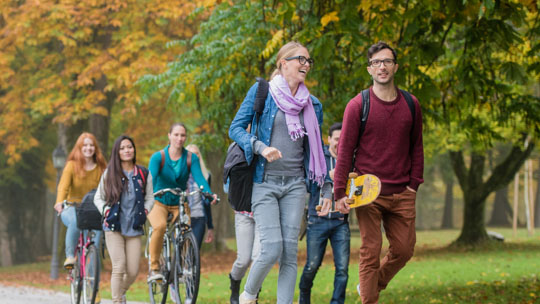QS China Summit 2024: Shaping the future of education
The highly anticipated QS China Summit 2024 is set to take place on April 17th and 18th, bringing together leading players in the education sector to discuss the future of higher education in China. With this year’s theme, “Remaining Distinct in Global Higher Ed: China’s Place in the New World of Education” the event promises to host insightful discussions, thought-provoking panels, and exciting networking opportunities.
What can attendees expect from the QS China Summit 2024?
Day one: Charting the course for distinction
The summit kicks off with an opening ceremony, followed by an opening keynote address by Meng Liu, Head of the Liaison Office in China for the United Nations Global Compact. This sets the stage for the opening panel titled "China's Higher Education: A Report Card," featuring esteemed professionals who will provide valuable insights into the current state and future trajectory of Chinese education.
The day progresses with a series of compelling sessions:
- Points of difference (global engagement): This session explores China's unique position as an international student destination and hub for innovation. Discover the opportunities and challenges associated with global engagement.
- Fireside chat - Cultivating inclusivity in education and advancing global gender leadership: This discussion focuses on fostering inclusivity within the educational landscape and promoting gender leadership, addressing a crucial aspect of educational equity.
- Fostering distinction in Chinese higher education through digital innovation: This session delves into how Chinese universities can leverage digital advancements like AI and Big Data to enhance their offerings and stand out in the global landscape.
Day two: Building a future-ready educational ecosystem
Day two commences with a thought-provoking fireside chat titled "Navigating the future: corporate sustainability and graduates' hiring criteria in today's workforce." This discussion explores the growing importance of sustainability in corporate strategies and its impact on graduate recruitment.
The day unfolds with a series of enriching panel discussions:
- From lab to life (research and innovation): This session highlights the crucial role of universities in research and innovation, showcasing how they generate knowledge and drive groundbreaking discoveries.
- Tech talk: navigating the future of technology (innovation & knowledge transfer): This session tackles the ever-evolving technological landscape, examining how educators can navigate the challenges and opportunities presented by advancements like generative AI.
- On the move: why student mobility matters (student mobility): This session underlines the significance of student mobility in fostering global understanding, cultural exchange, and innovation, exploring how China can further participate in this crucial aspect of education.
The summit culminates with a closing keynote address by George Loh, Associate Vice President (Strategic Partnership) at the National University of Singapore, followed by the closing ceremony.
Beyond the sessions: A platform for connection
The QS China Summit 2024 offers more than just informative sessions. It provides a valuable platform for networking with peers, industry experts, and thought leaders from the education sector. Attendees can establish connections, share experiences, and explore potential collaborations, fostering a dynamic environment conducive to shaping the future of education in China.
Join the conversation, shape the future
The QS China Summit 2024 presents a unique opportunity for anyone invested in the future of Chinese higher education. Register now and be part of this pivotal event that promises to spark insightful discussions, ignite innovation, and pave the way for a brighter future in education.
The highly anticipated QS China Summit 2024 is set to take place on April 17th and 18th, bringing together leading players in the education sector to discuss the future of higher education in China.
Master of Science in Computer Vision graduates look to the future
Sponsored by DigiPen Institute of Technology
Recently, DigiPen (Singapore) graduated its inaugural cohort of students from the Master of Science in Computer Vision (MS in Computer Vision) program. This master’s degree spans four trimesters of studies and is suitable for those who have a bachelor’s degree in computer science or a related field.
MS in Computer Vision helps to bridge the knowledge gap between basic foundations in machine learning while introducing students to industry-standard applications of computer vision technologies through in-depth studies in mathematics and computer science principles.
DigiPen (Singapore) admitted the first cohort of MS in Computer Vision students in August 2022, and among them were Saw Han Soo and Hriday Bhoyar. Han Soo had previously graduated with a BS in Computer Science and Game Design from DigiPen (Singapore) in 2020. He had been working on a virtual reality product when he first heard about MS in Computer Vision. The program’s curriculum and specialised focus in computer vision piqued Han Soo’s interest, seeing as he is a visual person.
“I have a background in traditional drawing, painting, 3D modeling, and animation,” Han Soo says. “I see how mathematical algorithms can make artwork beautiful and how scripting can speed up workflows all with the press of a button. You become a magician to create imagery out of nothing.”
As for Hriday, he holds a bachelor’s degree in mathematics from Nagpur University in India and had been working in the IT industry for over 15 years when he came across the MS in Computer Vision programme.
Most recently, Hriday has spent the last eight years as a principal database engineer and architect at Robert Bosch in Singapore. In his role, Hriday leads and manages the database team, overseeing project management, handling escalations, customer consultations, and project deployments. Hriday was drawn to computer vision’s potential across various domains and its innovative uses.
“Computer vision applications range from image recognition to video analysis, and this has profound implications in fields like healthcare, autonomous vehicles, and augmented reality,” he says. “The prospect of enabling machines to perceive and comprehend the visual world aligns with my own passion in leveraging technology to address real-world challenges.”

Over the span of 16 months, the students undertook modules such as Mathematical Elements for Computer Vision, Machine Learning and Pattern Recognition, and Deep Learning Models. Though Han Soo and Hriday both agree that managing the workload and complexity of the courses on top of their full-time jobs was challenging, they overcame by managing their time effectively, collaborating with peers, and seeking assistance from the professors when needed.
This all paid off. Hriday fondly recalls a highlight of the program when he got to design and implement his capstone project. Combining his passion for technology and innovative solutions with a social focus, Hriday developed a vision-based fall detection system.
The system aimed to enhance the safety of elderly individuals by detecting falls using computer vision techniques and triggering alert notifications to family members and nearby hospital facilities.
In Han Soo’s case, he appreciated the relevance of the MS in Computer Vision program, as he was often immediately able to apply what he had learned. In particular, he most enjoyed learning how fundamental mathematical concepts could be translated into machine learning applications.
Han Soo has since landed a position as a research engineer at Singapore Institute of Technology, where he works on an autonomous driving perception project. He is keen to both apply and further his newly acquired knowledge in computer vision and aims to write his own machine learning mathematical functions — as well as build his own 3D generation projects — one day.
Hriday plans to find a position that aligns with his expertise and will allow him to apply advanced computer vision techniques to solve real-world problems. He hopes to work on projects that will not only challenge him professionally, but also have a positive impact on society.
We spoke to graduates Hriday Bhoyar and Saw Han Soo, who shared about their experiences in the program.
Liverpool School of Tropical Medicine (LSTM)
My experience studying a MSc in transformative sustainability
Sponsored by Bocconi University
Jing Wang is a student at Bocconi University, studying an MSC in transformative sustainability. A fast-growing area of interest for both students and employers, transformative sustainability refers to the changes in societal practices, policies, and mindsets that are required to ensure long-term environmental, social, and economic well-being.
It goes beyond incremental changes, advocating for radical transformations in industries, governance, and individual behaviors, allowing graduates to have real impact on the future of our planet, by addressing the root causes of environmental degradation, social inequality, and economic instability.
The potential for high impact is what attracted Jing to studying the subject. We spoke to them to learn more about their experience studying transformative sustainability at Bocconi University and living abroad in Milan, Italy.

When did you first develop an interest in studying sustainability?
I attended a seminar on low carbon and smart energy, and this experience proved to be transformative, introducing me to a realm of ideas. During the seminar, I gained profound insights into sustainability innovation across diverse industries such as architecture, urban planning, the internet, materials, and third-party ratings.
One particularly impactful moment was when a speaker shared how they integrated the location of a tree in front of a building into green building rating criteria, influencing residents' traffic choices. This narrative, highlighting the profound impact achievable through small details, resonated deeply with me.
This experience taught me that we have transitioned into a new era of sustainability—one that extends beyond individual green lifestyle choices to encompass the transformation of entire industrial structures.
What attracted you to the transformative sustainability programme offered by Bocconi?
Once I had clarified my career direction, I embarked on a meticulous exploration of sustainability-related programmes. Bocconi University's two-year programme stood out as a distinctive offering, combining the academic strengths of a business school and a polytechnic.
The curriculum is comprehensive, encompassing diverse facets such as environmental technology, finance, management, and law. This holistic approach aligns with my belief in the necessity of a multifaceted knowledge background for professionals in this rapidly evolving field.
Because I studied finance at undergraduate level, I view this programme as a unique opportunity for a seamless transition into the sustainability track. Furthermore, the prospect of learning a new language as part of this programme adds another layer of enrichment to my educational journey.
This endeavor not only enhances my adaptability but also underscores my commitment to embracing new challenges in pursuit of a more sustainable future.
What have been the highlights of your learning experience?
This programme offers a wealth of learning opportunities. The first semester's curriculum is exceptionally comprehensive, spanning fundamental business school concepts and delving into innovative models within the sustainability field. The learning methodology is diverse, incorporating lectures, guest lectures, group assignments, individual tasks, and examinations. Group assignments, in particular, are invaluable in consolidating and applying acquired knowledge. Beyond the academic benefits, they foster in-depth communication among classmates, facilitating the development of lasting friendships.
The overall class atmosphere is friendly and harmonious. Activities led by class representatives, such as Christmas gift exchanges, contribute to my vibrant and engaging experience. Particularly for me, coming from a university with no scheduled classes during this period, the Bocconi class environment has been instrumental in building connections and expanding my social circle.
What have you enjoyed the most about living in Milan?
Milan boasts an exceptional geographical location and a well-established transportation system, I went to some diverse Italian towns around Milano with distinctive styles. Exploring these unique destinations is conveniently facilitated by efficient train services, enabling day trips that are both relaxing and cost-effective. The accessibility to a variety of charming Italian towns adds a delightful dimension to my overall experience in Milan.

What would you recommend to other Chinese students considering a degree at Bocconi?
Primarily, Bocconi's programmes typically span two years, offering an ideal timeframe for students seeking ample opportunity to fortify their backgrounds before entering the job market.
Secondly, Bocconi's prominent standing in Europe makes it particularly well-suited for those intending to establish their careers in the European professional landscape.
Lastly, the programme's rigorous curriculum ensures a robust educational experience, allowing students to acquire valuable knowledge and enhance their skills. Therefore, for students seeking an extended academic journey with a focus on practical learning and future European career prospects, Bocconi emerges as a highly advantageous choice.
Jing Wang is a student at Bocconi University, studying an MSC in transformative sustainability. We spoke to them to learn more about their experience studying transformative sustainability at Bocconi University and living abroad in Milan, Italy.
兰开斯特大学管理学院
Lancaster University Management School
George Washington University School of Business
George Washington University School of Business
Why giving machines the ability to ‘see’ could transform the way we live
Vision is arguably the next frontier for AI companies. After all, the ability to see underpins almost every aspect of human life, and being able to develop machines that can see, process, and comprehend the world, just like a human would, can transform the way we live and work.
In the American cartoon The Jetsons, the titular family lives in a futuristic world of technological convenience, with household chores attended to by Rosie, a robotic maid and housekeeper. Rosie is able to see and understand the world around her just as humans do, enabling her to carry out her tasks and respond to the Jetsons’ shenanigans.
While robots like Rosie are still far from becoming reality, giving machines the ability to ‘see’ like humans — also known as computer vision — is a key branch of AI research and development today.
“The main purpose [of computer vision] is to try to mimic human vision,” says Liu Fang, associate professor at the department of computer science at DigiPen Institute of Technology Singapore, a specialised university focused on the digital economy. “It aims to recognize visual inputs and process them as fast as humans can.”
Vision is arguably the next frontier for AI companies. After all, the ability to see underpins almost every aspect of human life, and being able to develop machines that can see, process, and comprehend the world, just like a human would, can transform the way we live and work.
The evolution of computer vision
One of the earliest and most well-known uses of computer vision came up in the 1970s with the development of optical character recognition (OCR) but not much progress was made in the field until the 2000s, which marked significant growth in the AI industry.
According to Liu, the advent of deep learning and neural networks transformed how researchers understand and work with computer vision, especially in the process of feature extraction. This refers to the transformation of image data into numerical features that can be processed by a machine, which is how a computer is able to ‘see’ images.
“Instead of having to half-manually extract features from images, we could now train computers to automatically perform this feature extraction and identify objects,” she explains. “This has fundamentally changed the things we can do around computer vision.”
Previously, researchers had to code algorithms from scratch for feature extraction to occur. However, this meant that each feature was only suited for a specific use case and couldn’t be applied universally across different scenarios. With neural networks, researchers can now ‘teach’ models what to look out for, making it easier to develop programs that can be applied to the real world.
The power of computer vision
Thanks to the rise in deep learning, existing applications of computer vision today are things that would have been unfathomable just 50 years ago.
In healthcare, for example, computer vision technology plays a key role in the analysis of medical images, helping doctors identify abnormalities from ultrasounds, MRIs and CT scans. The technology has also come up in surveillance and security, being able to pinpoint threats or unusual behaviours.
For Liu, an interesting application lies in the realm of self-driving cars. She points to ‘Tesla Vision’, the electric vehicle firm’s autopilot system enabled by cameras, as an example of AI-based computer vision in action.
“Instead of just using radar, which is only good for gauging distance, Tesla is using computer vision to identify and recognise objects on the road,” Liu explains. “By understanding what exactly it is seeing, the AI behind the self-driving technology can better understand the situation and react accordingly.”
In the near future, Liu envisions that computer vision can be combined with other new emerging technologies, such as virtual reality (VR) and augmented reality (AR), to enhance user experiences.
This technology has useful applications in areas such as medicine, where AR can help in training medical students and planning surgeries, as well as in engineering and manufacturing, where training and tests involving heavy machinery can be done in simulations.
The road ahead
While computer vision has come far, it still faces several limitations. Computational challenges and issues with processing power are a key hurdle that many computer vision models struggle with. Computer vision systems are also lacking in key aspects of mimicking human vision — while they are capable of recognising individual objects, they cannot understand the scenes they’re looking at.
Additionally, the sector struggles with talent. In Asia-Pacific alone, it has been estimated that there will be a shortage of 47 million people by 2030, with the AI talent gap being a barrier to the growth of the sector.
However, much is being done to address these hurdles. Liu shares that researchers are looking at combining computer vision with other technologies such as natural language processing to close the gaps in what computer vision can do. Some scientists have combined language processing models with computer vision technology to allow machines to understand context, creating AI models that can parse both language and visuals.
“At present, we don’t need it to understand what it is seeing exactly as humans do, but we want it to be able to build a representation of the content in the scene, which will help the AI make better decisions,” Liu explains.
On the talent front, governments and institutions are working to build up the pool of AI talent. The Singapore government, for one, has rolled out a comprehensive series of programmes to develop talent in the AI space, while DigiPen Singapore has launched a master’s degree in computer vision to help address this talent gap.
“We need to have a broader base of AI talent in order to create that synergy for more development and ideas,” Liu says.
“However, as computational resources grow and more talent comes into the space, we’ll be seeing even more exciting applications and developments,” she concludes. “We’re just limited by our own imagination.”
---
This article was originally published on Tech in Asia’s website on 6 May 2022.
Vision is arguably the next frontier for AI companies. After all, the ability to see underpins almost every aspect of human life, and being able to develop machines that can see, process, and comprehend the world, just like a human would, can transform the way we live and work.



